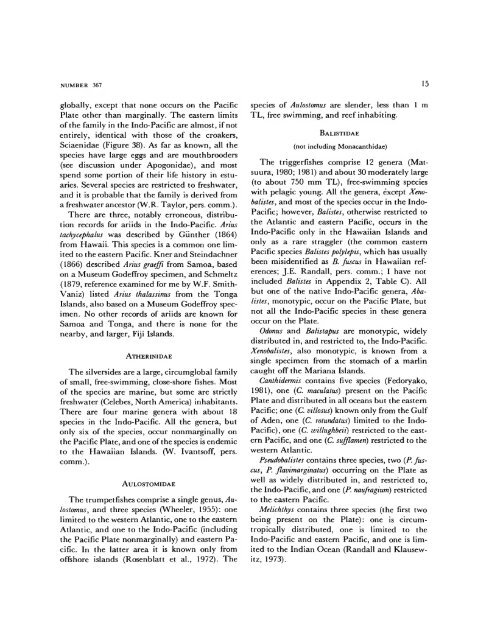Pacific Plate Biogeography, with Special Reference to Shorefishes
Pacific Plate Biogeography, with Special Reference to Shorefishes
Pacific Plate Biogeography, with Special Reference to Shorefishes
You also want an ePaper? Increase the reach of your titles
YUMPU automatically turns print PDFs into web optimized ePapers that Google loves.
NUMBER 367<br />
globally, except that none occurs on the <strong>Pacific</strong><br />
<strong>Plate</strong> other than marginally. The eastern limits<br />
of the family in the Indo-<strong>Pacific</strong> are almost, if not<br />
entirely, identical <strong>with</strong> those of the croakers,<br />
Sciaenidae (Figure 38). As far as known, all the<br />
species have large eggs and are mouthbrooders<br />
(see discussion under Apogonidae), and most<br />
spend some portion of their life his<strong>to</strong>ry in estuaries.<br />
Several species are restricted <strong>to</strong> freshwater,<br />
and it is probable that the family is derived from<br />
a freshwater ances<strong>to</strong>r (W.R. Taylor, pers. comm.).<br />
There are three, notably erroneous, distribution<br />
records for ariids in the Indo-<strong>Pacific</strong>. Arius<br />
tachycephalus was described by Giinther (1864)<br />
from Hawaii. This species is a common one limited<br />
<strong>to</strong> the eastern <strong>Pacific</strong>. Kner and Steindachner<br />
(1866) described Arius graeffi from Samoa, based<br />
on a Museum Godeffroy specimen, and Schmeltz<br />
(1879, reference examined for me by W.F. Smith-<br />
Vaniz) listed Arius thalassinus from the Tonga<br />
Islands, also based on a Museum Godeffroy specimen.<br />
No other records of ariids are known for<br />
Samoa and Tonga, and there is none for the<br />
nearby, and larger, Fiji Islands.<br />
ATHERINIDAE<br />
The silversides are a large, circumglobal family<br />
of small, free-swimming, close-shore fishes. Most<br />
of the species are marine, but some are strictly<br />
freshwater (Celebes, North America) inhabitants.<br />
There are four marine genera <strong>with</strong> about 18<br />
species in the Indo-<strong>Pacific</strong>. All the genera, but<br />
only six of the species, occur nonmarginally on<br />
the <strong>Pacific</strong> <strong>Plate</strong>, and one of the species is endemic<br />
<strong>to</strong> the Hawaiian Islands. (W. Ivantsoff, pers.<br />
comm.).<br />
AULOSTOMIDAE<br />
The trumpetfishes comprise a single genus, Aulos<strong>to</strong>mus,<br />
and three species (Wheeler, 1955): one<br />
limited <strong>to</strong> the western Atlantic, one <strong>to</strong> the eastern<br />
Atlantic, and one <strong>to</strong> the Indo-<strong>Pacific</strong> (including<br />
the <strong>Pacific</strong> <strong>Plate</strong> nonmarginally) and eastern <strong>Pacific</strong>.<br />
In the latter area it is known only from<br />
offshore islands (Rosenblatt et al., 1972). The<br />
species of Aulos<strong>to</strong>mus are slender, less than 1 m<br />
TL, free swimming, and reef inhabiting.<br />
BALISTIDAE<br />
(not including Monacanthidae)<br />
The triggerfishes comprise 12 genera (Matsuura,<br />
1980; 1981) and about 30 moderately large<br />
(<strong>to</strong> about 750 mm TL), free-swimming species<br />
<strong>with</strong> pelagic young. All the genera, except Xenobalistes,<br />
and most of the species occur in the Indo-<br />
<strong>Pacific</strong>; however, Batistes, otherwise restricted <strong>to</strong><br />
the Atlantic and eastern <strong>Pacific</strong>, occurs in the<br />
Indo-<strong>Pacific</strong> only in the Hawaiian Islands and<br />
only as a rare straggler (the common eastern<br />
<strong>Pacific</strong> species Balistes polylepis, which has usually<br />
been misidentified as B. fuscus in Hawaiian references;<br />
J.E. Randall, pers. comm.; I have not<br />
included Balistes in Appendix 2, Table C). All<br />
but one of the native Indo-<strong>Pacific</strong> genera, Abalistes,<br />
monotypic, occur on the <strong>Pacific</strong> <strong>Plate</strong>, but<br />
not all the Indo-<strong>Pacific</strong> species in these genera<br />
occur on the <strong>Plate</strong>.<br />
Odonus and Balistapus are monotypic, widely<br />
distributed in, and restricted <strong>to</strong>, the Indo-<strong>Pacific</strong>.<br />
Xenobalistes, also monotypic, is known from a<br />
single specimen from the s<strong>to</strong>mach of a marlin<br />
caught off the Mariana Islands.<br />
Canthidermis contains five species (Fedoryako,<br />
1981), one (C. maculatus) present on the <strong>Pacific</strong><br />
<strong>Plate</strong> and distributed in all oceans but the eastern<br />
<strong>Pacific</strong>; one (C villosus) known only from the Gulf<br />
of Aden, one (C. rotundatus) limited <strong>to</strong> the Indo-<br />
<strong>Pacific</strong>), one (C. willughbeii) restricted <strong>to</strong> the eastern<br />
<strong>Pacific</strong>, and one (C sufflamen) restricted <strong>to</strong> the<br />
western Atlantic.<br />
Pseudobalistes contains three species, two (P. fuscus,<br />
P. flavimarginatus) occurring on the <strong>Plate</strong> as<br />
well as widely distributed in, and restricted <strong>to</strong>,<br />
the Indo-<strong>Pacific</strong>, and one (P. naufragium) restricted<br />
<strong>to</strong> the eastern <strong>Pacific</strong>.<br />
Melichthys contains three species (the first two<br />
being present on the <strong>Plate</strong>): one is circumtropically<br />
distributed, one is limited <strong>to</strong> the<br />
Indo-<strong>Pacific</strong> and eastern <strong>Pacific</strong>, and one is limited<br />
<strong>to</strong> the Indian Ocean (Randall and Klausewitz,<br />
1973).<br />
15

















